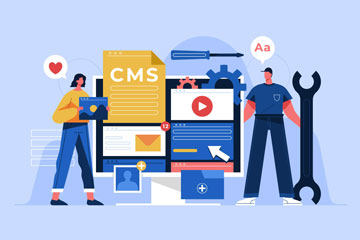
Searching for an enterprise content management system? Our website development company in London is here to guide you through the various choices you have and how to pick the right one for your business.
Websites were page-per-page coded in the early days of the world wide web. Developers created software that could enable planning and creating sites as well as helping to manage the ever-growing amounts of material that were passing through them as websites became more complicated.
Developers created software that laid the foundation for contemporary content management systems (CMS). A content management system (CMS) is currently a crucial component of website development, especially for corporate businesses that need to be able to manage big amounts of content and numerous users.
We are currently a part of the next significant CMS change, moving away from slower developer-dependent projects. We're now moving towards an agile marketing team-led approach to development that is supported by no-code visual technologies.
Open Source CMS
Every developer can contribute to the source code of an open-source CMS, which is a tool for creating websites. This implies that when utilising this software, you may install a wide range of add-ons, plug-ins, and templates, and your programmers can develop whatever new functionality your site requires.
WordPress and other open-source web development tools were the pioneers of the modern content management system (CMS) and more user-friendly visual development tools. WordPress is still the most widely used platform online, although it has several drawbacks due to the requirement for plug-ins and developer assistance for additional code.
Platforms for Digital Experiences
A digital experience platform, or DXP, is an integrated software framework with a set of tools to manage every aspect of designing and publishing a sizable, enterprise-level website, including managing content.
DXPs are crucial for businesses with a wider reach because they can manage higher amounts of material and synchronise that content across a network of websites – imagine subdomains for firm subsidiaries or sites for several nations. Developers create the templates and components for the websites within the software, which designers may subsequently put together.
Headless CMS
Several businesses adopted what is known as a headless CMS method in response to the concern that front-end development approaches might surpass back-end infrastructure.
A headless CMS separates the "head"—the user-interactive front-end website—from the "back-end" (content). This separation allows web designers to construct a new front end using modern technology and plug it into the old back-end whenever a tool or approach, such as the DXP language discussed above, becomes outdated.
By doing this, a business may change the front end without having to expend the enormous effort of migrating its content from one database to another. The disadvantage of this strategy is that you have to engage developers to create each customer-facing website from scratch
Conclusion
When choosing a CMS, you should take into account a few CMS features and traits. You need a platform that will enable the kind of workflow you desire for your team in addition to the technological elements that ensure your site is safe and functions efficiently. Get in touch with V1 Technologies, we can help you meet all your business requirements hassle-free.